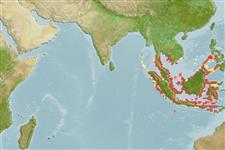Common names from other countries
Environment: milieu / climate zone / depth range / distribution range
Ecologie
; diepteverspreiding 0 - 1 m (Ref. 119695). Tropical; 12°N - 12°S, 91°E - 123°E (Ref. 119694)
Indo-West Pacific.
Length at first maturity / Size / Gewicht / Leeftijd
Maturity: Lm ? range ? - ? cm Max length : 100.0 cm TL mannelijk/geslacht niet bekend; (Ref. 8812); Maximaal gepubliceerd gewicht: 1.6 kg (Ref. 356)
Total Length: 89 to 100 cm; Wingspan: 206 to 230 cm (Ref. 8812). Minimum and maximum depth ranges are based on feeding behavior of dipper types of seabirds (Ref. 119695). This is to be replaced with better references. Surface feeding; scavenging; kleptoparasitism; oceanic; warm, low-salinity waters of the south Equatorial Current (Ref. 356).
Li, X. 1990. (Ref. 78638)
Status op de Rode Lijst van het IUCN (Ref. 130435)
Status bij CITES (Ref. 108899)
Gebruik door de mens
| FishSource |
Tools
Internet-bronnen
Estimates based on models
Preferred temperature
(Ref.
115969): 9.1 - 20.3, mean 11.8 (based on 122 cells).
Kwetsbaarheid
High vulnerability (60 of 100).
Prijsklasse
Unknown.
